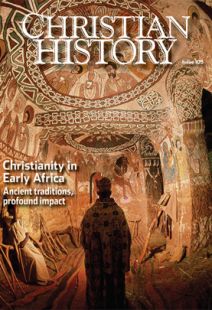Saved from the compost heap
NAG HAMMADI was a fairly unknown city in Upper Egypt until one day in 1945. Egyptian farmers knew that ancient papyrus would enrich their fields, and a farmer out digging for compost discovered 12 codices (bound books) in a sealed jar. No one immediately recognized the importance of the books. In fact, some were used as kindling for fires. One found its way to a Belgian antiquities dealer, from whom the Carl Gustav Jung Institute
in Zurich purchased it in 1951.
Hidden knowledge
Scholars eventually analyzed over 50 different works from the Nag Hammadi texts written in Coptic and theorized that they were probably hidden by monks from a nearby monastery in the mid-fourth century, possibly after reading a condemnation of noncanonical New Testament sources by Athanasius (see “Some others you should know,” pp. 36–37).
The Nag Hammadi codices are sometimes termed the “Gnostic Gospels, “ though they include a variety of genres. They most recently came to popular attention through Dan Brown’s novel The Da Vinci Code. The orthodox strand of early Christianity did not exist in a vacuum, and the Nag Hammadi texts illuminate the beliefs and practices of popular ancient groups known broadly as “Gnostics.”
These groups, widespread across the early Christian world, drew much inspiration from pagan philosophy. (See CH issue 96, The Hunger for Secret Knowledge.)They emphasized the power of learning and the wickedness of the world around them. They believed that one could only find the true God and escape the evils of the material world by attaining to special knowledge (gnosis in Greek).
One person’s trash...
Nag Hammadi is not the only place in Africa where archaeologists have dug up buried history. The town of Oxyrhyncus (modern el-Bahnase in Egypt, south-west of Cairo) was an important Roman settlement.
Excavations in 1896 by Oxford archaeologists Bernard Grenfell and Arthur Hunt yielded a great number of papyri from the town rubbish dumps, most of them very well preserved by the dry climate.
Many of the texts relate to daily secular concerns: bills, receipts, tax records, even spells. Some are works of literature. But a significant number are copies of Old and New Testament sources as well as noncanonical texts.
The New Testament sources are especially noteworthy for their age. Some date from the second century AD, and the codices are the largest category of New Testament papyrus documents anywhere in the world. “Papyrus 90,” currently in the Sackler Library in Oxford, England, was dated to around AD 150 on the grounds of writing style. It contains a fragment of the Gospel of John (18:36–19:7).
Other noncanonical texts include the so-called Gospels of Thomas, James, Peter, and Mary, as well as the Shepherd of Hermas, an important text for Christians in the second and third centuries which is full of symbolic and allegorical writing. Some of the documents in this huge trove are still in the process of being translated. CH
By Niall Finneran
[Christian History originally published this article in Christian History Issue #105 in 2013]
Niall FinneranNext articles
From Abba Salama to King Lalibela
Christian traditions in Ethiopia are among the oldest in the world
Tekletsadik BelachewThe Bible’s story is our story
How Alexandria shaped the early church’s way of reading the Bible
Joseph TriggSee how these Christians love one another
How Carthage in North Africa gave the early Western church its emphasis on unity.
J. Warren SmithSupport us
Christian History Institute (CHI) is a non-profit Pennsylvania corporation founded in 1982. Your donations support the continuation of this ministry
Donate



